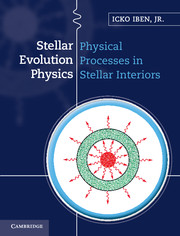Book contents
- Frontmatter
- Contents
- Preface
- Part I Introduction and overview
- Part II Basic physical processes in stellar interiors
- Part III Pre-main sequence, main sequence, and shell hydrogen-burning evolution of single stars
- 9 Star formation, pre-main sequence evolution, and the zero age main sequence
- 10 Solar structure and neutrino physics
- 11 Evolution through hydrogen-burning phases of models of mass 1, 5, and 25 M☉
- Index
- References
9 - Star formation, pre-main sequence evolution, and the zero age main sequence
from Part III - Pre-main sequence, main sequence, and shell hydrogen-burning evolution of single stars
Published online by Cambridge University Press: 05 December 2012
- Frontmatter
- Contents
- Preface
- Part I Introduction and overview
- Part II Basic physical processes in stellar interiors
- Part III Pre-main sequence, main sequence, and shell hydrogen-burning evolution of single stars
- 9 Star formation, pre-main sequence evolution, and the zero age main sequence
- 10 Solar structure and neutrino physics
- 11 Evolution through hydrogen-burning phases of models of mass 1, 5, and 25 M☉
- Index
- References
Summary
The saga of pre-stellar evolution begins with the Big Bang and the evolution of large scale structure, continues with the formation of galaxies and giant molecular clouds, and extends finally to the formation of protostellar condensations that collapse into objects recognized as stars which, evolving on a quasistatic time scale, form the main subject of this book.
Nucleosynthesis, beginning with protons and neutrons in the early phases of the expanding Universe, prior to the formation of structure, is responsible for the fact that hydrogen and helium are the most abundant elements in the Universe. The presence in the current Universe of elements such as carbon, nitrogen, oxygen, and iron, coupled with the fact that these elements are not produced in models of the early Universe, is evidence that stars make these elements and inject them into the interstellar medium. Thus, the initial composition and therefore the detailed evolutionary history of stars of a given generation differs from the composition and history of stars of earlier and later generations.
Whatever the physics is that is responsible for their existence, giant molecular clouds are the birthplaces of smaller condensations, or protostellar clouds, which are thought to develop into protostars consisting initially of small, quasistatic cores that accrete from dynamically collapsing envelopes. In Section 9.1, some considerations involved in understanding the properties of giant molecular clouds and early protostar evolution are presented. After almost a century of thought, where a real star appears in the HR diagram as an isolated, quasistatically evolving object has not been determined from first principles.
Information
- Type
- Chapter
- Information
- Stellar Evolution Physics , pp. 529 - 636Publisher: Cambridge University PressPrint publication year: 2012
